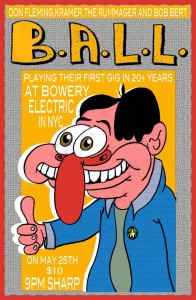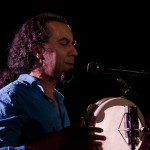Date: April 17, 2013
Venue: ZirZamin (NY)
Review by Matt Cole
 I saw The Red Microphone for the first time at their CD release show at ZirZamin for The Red Microphone Speaks!, and was thus happy to see that they were a quartet consisting of four members of the Dissident Arts Orchestra, who had created a fine improvised soundtrack to Eisenstein’s classic Battleship Potemkin a few months back. Specifically, The Red Microphone consists of John Pietaro on vibraphone and percussion; Ras Moshe on tenor and soprano sax, flute, and spoken words; Rocco John Iacovone on alto and soprano sax, and Nicolas Letman-Burtinovic on bass.
I saw The Red Microphone for the first time at their CD release show at ZirZamin for The Red Microphone Speaks!, and was thus happy to see that they were a quartet consisting of four members of the Dissident Arts Orchestra, who had created a fine improvised soundtrack to Eisenstein’s classic Battleship Potemkin a few months back. Specifically, The Red Microphone consists of John Pietaro on vibraphone and percussion; Ras Moshe on tenor and soprano sax, flute, and spoken words; Rocco John Iacovone on alto and soprano sax, and Nicolas Letman-Burtinovic on bass.
It can be a challenge for musicians to play free music in sync with each other, but The Red Microphone manages to be a very tight, cohesive unit. The music started with a driving baseline and ethereal vibraphone sounds, and soon the two saxes came in playing in harmony, at times sounding like they were in different keys that nonetheless created a good sound, not unlike what Charles Ives might have written had he anticipated the free music of the ’60s or the Downtown flowering of the ’80s and beyond. The overall sound was rooted in modern avant-garde jazz, leaning towards the free end; the sounds of rock, hard bop, and even a hint of modern classical also could be heard in the mix. Right away, I noticed that there was a lot of communication between the band members, enabling them to move together as a single unit, changing rhythms, feel, and tempo with ease (or at least it looked that way to Yours Truly, watching from the audience). Themes would appear, bounce around, make an impression, and vanish into the ether like a pair of virtual particles in sub-Planck time. The band members took turns taking the lead, with tenor man/flautist Ras Moshe playing bluesy, uplifting solos with a definite undertone of urgency just beneath (and often breaking) the surface. Throughout the set, the band showed a talent for evolving pieces, with individual instruments coming in and out over time as the music grew.
Continue reading →
 Venue: Bowery Electric (NY) May 25, 2013
Venue: Bowery Electric (NY) May 25, 2013



